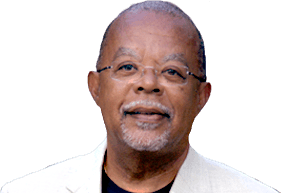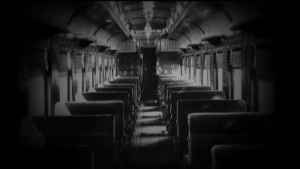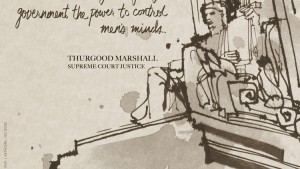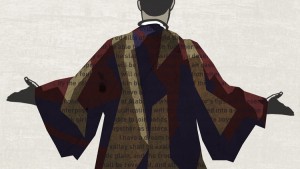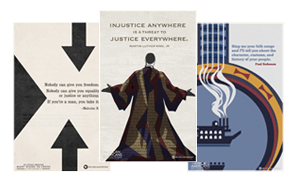What Was the Civil Rights Movement?
A silly question, right? I thought so, too, until I learned that in the year 2010, only 2 percent of 12th graders received full credit in identifying the following quote on the National Assessment of Educational Progress U.S. History Exam: ” … Separate education facilities are inherently unequal.” The 12,000 students tested didn’t need to come up with the name Brown v. Board of Education, mind you — just know it had something to do with 1.) segregation 2.) in the nation’s schools — yet a stunning 73 percent either skipped it or received an “inappropriate” score.
“What’s going on?” I asked myself, thinking about the refrain of Marvin Gaye’s canonical song that captured so brilliantly the sense of frustration and angst that so many of us felt in those years following the assassination of Dr. Martin Luther King Jr. as the Black Panthers and the Cultural Nationalists seemed to be doing their best to annihilate each other, while the FBI was doing its best to annihilate them both!
Brown v. Board of Education was not only a landmark U.S. Supreme Court case for black people; it’s arguably the most important case in American legal history and one that, more than any other, affected all Americans by making de jure segregation illegal, and integration the goal of our ever more multicultural society.
Like I said, I had no idea (or had I wished it away?), until Khalil Gibran Muhammad, the director of the Schomburg Center for Research in Black Culture at the New York Public Library, reminded an audience on Martha’s Vineyard two weeks ago of a report that the Southern Poverty Law Center had issued in 2011. Its title: Teaching the Movement: The State of Civil Rights Education in the United States Since 2011. I can boil its 108 pages of solid facts down to one sentence: The situation is “dismal.” The American school system is inexcusably treating the civil rights movement, essentially, as if it never happened, part of a collective, general amnesia about African-American history as a whole. And we cannot allow this to continue.
This month, countless Americans will gather in front of televisions and computer screens across the land — or even go to the Mall — to commemorate the 50th anniversary of the emotional highpoint of the civil rights movement, the March on Washington. Yet as the SPLC’s report reveals, where it really matters, where it counts most, in our nation’s public schools, far too many educators (and curriculum writers) view the movement “mainly as African-American or regional history.” In other words, while we may pause — some of us even weep — in claiming the “I Have a Dream” speech (pdf) Martin Luther King Jr. delivered on the steps of the Lincoln Memorial on August 28, 1963 as our speech, one of the greatest in our history, what’s really going on is that those overseeing the education of the next generation of dreamers conceive of the civil rights movement as niche history. They see it as being for and about black people, who, for the most part, reside in cities and/or in the South. As some of them might say: Aren’t MLK Day and Black History Month enough?
Why are the schools so important in preserving the historical memory of crucial events in black history, such as the march? Because it is in our schools that we shape, almost unconsciously, the shared sense of identity that makes us all citizens of a common republic. It is in the schools, from kindergarten on, that students imbibe the stories that the country tells itself about itself, about its history, its purpose, its raison d’être.
Want a meaningful “conversation about race”? That conversation, to be effective and to last, to become part of the fabric of the national American narrative, must start in elementary school, and continue all the way through graduation from high school. It must do this in the same way that the story of the Mayflower, the Pilgrims, the Puritans, the “City Upon a Hill” and the key, shaping stories and myths about ourselves that each American shares at the deepest level about what America is, was and continues to mean, was formulated for us through the school curriculum — from classroom content to participation in rituals such as reciting daily the Pledge of Allegiance and singing “My Country, ‘Tis of Thee.” Unless our story becomes part and parcel of the common content of these rituals and teaching lessons, the stories of black ancestors’ sacrifices and accomplishments will not become part of the national narrative, not part of that “more perfect union.”
The Southern Poverty Law Center’s Report
Sensing the urgency of this crisis, the SPLC took a three-step approach in reviewing all 50 states’ standards for the school year 2011-2012. Through its Teaching Tolerance project, it established a benchmark for the “generally accepted core knowledge” any student should have about the civil rights movement, based on leading textbooks and historians. It scored each state with a letter grade, A through F. And it compared them. Let’s just say that the students who missed the Brown quote in 2010 weren’t alone.
While I hope all concerned will read the report’s thorough breakdown (especially of your state), here’s a top view: A whopping 35 states received an F grade, which, according to the report, means they cover “less than 20 percent — or, in many cases none — of the recommended content.” In fact, 16 states require nothing “at all.” Check out the report (pdf) to see which ones.
As of 2011-2012, only 19 states specifically require teaching Brown v. Board of Education, while 18 states require coverage of MLK; 12, Rosa Parks; 11, the March on Washington; and six, Jim Crow segregation policies. It gets better, though, right? Actually, only three states in the report earned an A grade — Alabama (70 percent), New York (65 percent) and Florida (64 percent). Three other states, Georgia, Illinois and South Carolina, received B’s. And there were six C’s handed out (Lousiana, Maryland, Mississippi, Tennessee, Texas and Virginia) and three D’s (Arizona, Arkansas, Massachusetts), which was also the score Washington, D.C., the site of the March, received. Want an even bigger shock? Nine out of the 12 highest scorers were former Confederate states; the other three, Illinois, New York and Maryland, have large black populations.
Going behind the numbers, we learn that, as of 2011-2012, only 19 states specifically require teaching Brown v. Board of Education, while 18 states require coverage of MLK; 12, Rosa Parks; 11, the March on Washington; and six, Jim Crow segregation policies. Only one, Arkansas, covers one of the chief obstacles to the civil rights movement: the Ku Klux Klan. Yet open up a recent American newspaper and you’ll see that some states are actually clamoring for change in the opposite direction. In 2010, according to the New York Times, the Texas Board of Education voted in edits to its history textbooks that promoted a decidedly more Christian view of the nation’s founders (none of whom owned slaves, right?) while playing up the Black Panthers’ “violent philosophy” and emphasizing Republicans’ role in voting for the Civil Rights Act of 1964. If it gets its way, the Tea Party in Tennessee will do much of the same, apparently, according to the Wall Street Journal.
Whatever the reason for the SPLC’s findings — not enough instructional time because of No Child Left Behind, poor teacher preparation in schools of education or too low expectations — the civil rights movement and, more generally, African-American history, are being left out, and it’s not only black students who are suffering. You can’t have a “conversation about race” only among black people! This is American history, after all.
While I commend states like New Jersey, New York and Illinois for passing legislation establishing Amistad Commissions to ensure the interweaving of black history throughout their social studies curriculums, I must also note that other cities, like Philadelphia (pdf) and Chicago, feel they have no better option than to mandate stand-alone courses for their high school students. I wish more school systems would offer the same, just as we do in college.
And while these are very positive steps — most of us, after all, learned African-American history in these sort of classes — not even separate stand-alone courses can have the larger and more lasting effect of integrating and interweaving our ancestors’ stories into the common core of knowledge that every school child imbibes from the very first day of kindergarten. Teaching naturalizes history; the content that is taught in our schools makes knowledge second nature. And until the contributions of African Americans become second-nature to all American school children, desperate calls for one more “conversation about race” are destined to repeat themselves, in an endless cycle, following the next race-based hate crime.
“This will be the day,” Dr. King dreamed 50 years ago this August, “when all of God’s children will be able to sing with a new meaning, ‘My country, ’tis of thee, sweet land of liberty, of thee I sing. Land where my fathers died, land of the pilgrim’s pride, from every mountainside, let freedom ring.’ ” Dr. King was a careful student of history, keenly aware of the presence of the past in the present. (I think part of his strength as a leader of the movement was the depth of the historical knowledge he brought to the task of slaying Jim Crow.) Yet how many school students today could even name the tune to which he was referring, or sing its words, let alone place it in context or communicate the power behind Marian Anderson’s decision to change “of thee I sing” to “of thee we sing,” when she sang it so defiantly during her 1939 concert at the Lincoln Memorial, after the Daughters of the American Revolution had refused her manager’s request to have her perform at Constitution Hall?
It’s not enough to spotlight one leader’s clarion call for moral action at one moment in history — however magical — because the nature of the movement today, and the nature of the problems confronting the black community (and therefore America) today, are so much more complex than they were even then.
It’s a small example, I know, but shared knowledge like this is what I mean when I refer to the “common culture” that Americans should share, and which public schooling forges. And that is where “the content of the character” (to paraphrase Dr. King) of black history is being left out of the schools, and therefore of our larger society. For what place is “race” currently given in the curriculum, except for the acknowledgement of Kwanzaa (an African-American invention by Maulana Karenga) and homages to heroes such as Dr. King on his birthday and Rosa Parks during Black History Month?
Commemorating the 50th Anniversary of the March
Like just about everybody else in America at the time, I watched Dr. King give his “Dream” speech on a black-and-white television set, sitting with my mother and father in our living room, back home in West Virginia. I’ll commemorate the 50th anniversary by participating in a march on August 24. And this August 28, I plan on listening to it again, which I can’t seem to do without tearing up.
But listening to Dr. King’s mellifluous tones isn’t enough. It’s not enough to spotlight one leader’s clarion call for moral action at one moment in history — however magical — because the nature of the movement today, and the nature of the problems confronting the black community (and therefore America) today, are so much more complex than they were even then.
The civil rights movement was, as the SPLC reminds us, a series of events, leaders, groups, strategies and tactics, legislative acts, court cases and obstacles overcome — through decades in numerous jurisdictions — which was why Dr. King was so insistent on beginning his “Dream” speech with a reference to history. In his case, it was the history that had begun in Washington, at the Executive Mansion, with President Abraham Lincoln’s execution of the Emancipation Proclamation 100 years before King arrived at the podium. “Five score years ago, a great American, in whose symbolic shadow we stand today, signed the Emancipation Proclamation,” Dr. King reminded his listeners, only to add, “But 100 years later, the Negro still is not free.”
Basic Literacy About the Negro
In conceiving of this series, a tribute to the black journalist Joel A. Rogers, a witness to the civil rights movement who died in 1966 at age 85, I had no intention of covering the most outdated of his 100 Amazing Facts About the Negro, curious “facts” such as these:
No. 1: “The white population of New York is a third more illiterate than the Negro one.”
No. 19: “The peoples of Southern Europe, including Italy, and most of those of Eastern Europe, including Russia, are more illiterate than the Negroes of the United States. In seventy years Negro illiteracy has fallen off about 80 percent. In 1870 it was 82 per cent; in 1930, 16.3.”
No. 20: Though “Aframerican illiteracy [sic] is three times higher than the white one,” New York, Minnesota, Oregon and South Dakota “Negroes are less illiterate than Mississippi Whites.” And when you throw in California, Nevada and Washington; they’re “less illiterate by 100 to 400 per cent than the foreign-born Whites of all the States, save one.” And —
No. 21: “In the United States Army Intelligence tests during World War I, the Negroes of [Pennsylvania, New York, Illinois, and Ohio] led the Whites of [Mississippi, Kentucky, Arkansas and Georgia] by from one to seven per cent.”
I understood Rogers’ pre-Brown v. Board of Ed. reasons, of course, to prove with facts that African Americans were worthy of equal citizenship rights, but to me they no longer seemed relevant to readers in our time, especially when we now have an African-American former Constitution law professor sitting in the White House with degrees from Columbia University and Harvard Law School. But now I know there is a different burden to shoulder, a relevancy to convey with no less urgency: basic literacy for all Americans about a trulyAmerican history, reflecting its various intellectual complexions.
I know — math and science education is critical if we are going to compete with other advancing nations. But, remember, America isn’t exceptional only because of its capacity to lead the free world, but because it was conceived as an experiment meant to prove that ordinary people could govern themselves. At least that’s what I learned in school, and a similar spirit animated the broader civil rights movement itself five decades ago, as ordinary black and white citizens of goodwill struggled together to extend the founders’ aspiration to the descendants of their slaves — and, through them, to all people, “through Seneca Falls, and Selma, and Stonewall,” as President Obama summed it up in his second inaugural address.
Just ask anyone fighting for marriage equality today and, chances are, he or she will know something of the significance of Brown v. Board of Education. While I applaud California for becoming the first state to mandate the teaching of LGBT history in its schools, I also hope it and the 34 other states that received F’s in the SPLC study will redouble their efforts to narrow the gap between the suggestions they make and the requirements they implement for teaching the civil rights movement that has inspired so many others.
In this 50th anniversary season of the assassination of Medgar Evers, the March on Washington and the Birmingham Four, I will try to contribute to this basic literacy in my next two columns: the first on the march’s organizing genius, Bayard Rustin, a man who straddles both black and LGBT history, and the second on the “Dream” speech itself and its historical setting, the Lincoln Memorial.
The March Ahead
Want to honor the people who gave their lives and risked so much during the movement? Ask your school leaders to improve their design for teaching the history of the civil rights movement and for interweaving the sweep of African-American history into your child’s social studies curriculum. If that history teaches us anything, it is that it takes a movement to “bend” “the arc of the moral universe … toward justice.” And to appreciate everything about that quote, you’d have to have taken a history class or read a history book (or at least clicked around online) and imagined it applying to past, present and future causes. I’m certain that’s what Dr. King did in riffing off the 19th-century abolitionist Theodore Parker, and what we can do by teaching our kids about the movements both men helped lead, the movements that were bigger than them or any individuals — so big, in fact, they encompassed a nation and, in the face of violence and fear, summoned its “better angels” for a better future.
Fifty of the 100 Amazing Facts will be published on The African Americans: Many Rivers to Cross website. Read all 100 Facts on The Root.
Find educational resources related to this program - and access to thousands of curriculum-targeted digital resources for the classroom at PBS LearningMedia.
Visit PBS Learning Media